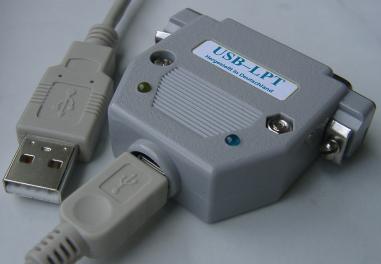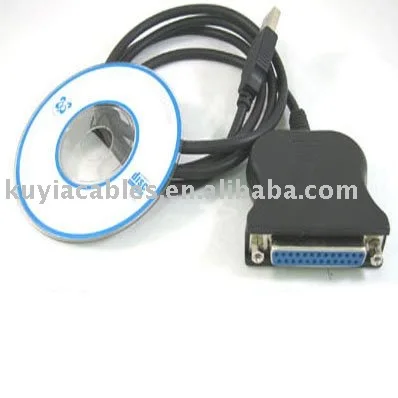Driver For Usb To Parallel Port
Converter From USB To Parallel. Contrary to all other USB→Parallel adapters which can connect to printers only, this makes connection to most hardware - without adapting the software! A parallel port will be virtualized by the accompanying driver. The entire circuitry fits into a usual D-Sub shell housing.
*This is the most common Application
 You can buy the USB to Parallel adapter with a Parallel to Mini Centronics adapter here. Check your printer for the correct connection.
You can buy the USB to Parallel adapter with a Parallel to Mini Centronics adapter here. Check your printer for the correct connection. The Sewell USB to Parallel boasts the highest compatibility rate in the industry!
This 5-foot USB to Parallel adapter allows you to connect your parallel printer to a USB port on your computer. The parallel end fits directly into the centronics connecter on your printer (36-pin). This adapter will not work with your all-in-one printer.
If your printer uses the mini-centronics connector (about half the size of the regular centronics), you can use the centronics to mini centronics converter along with the USB to Parallel adapter.
If you need a longer USB to Parallel adapter, just add a USB extension cable to your order. They come in lengths of 3, 6, and 10 feet.
For information on our USB to Serial Adapter, click here.
The USB to Parallel adapter is Plug & Play compatible and installs easily in seconds.
Trying to connect a parallel device other than a printer? Check out our Parallel PCMCIA Card for a true parallel port.
Related Articles
- 1 Operate Parallel Port Printers From USB Ports
- 2 Adapt Parallel Printer Settings With a USB Adapter
- 3 Connect a Parallel Printer to a Laptop Via FireWire or USB
- 4 Redirect COM1 to a USB Port

If your small business is typical, you want to get the longest lifespan possible from your tech investment, and therefore you may have an older dot-matrix or laser printer with a parallel port that you want to use with a modern computer. Since the early 2000s, USB has gradually become the standard for printer connections and therefore many modern PCs do not have parallel ports. You must use a USB-to-parallel adapter cable for older printers. Usually, installing the adapter and using it is relatively straightforward and hassle free. If you experience connection problems with the adapter, however, you can usually troubleshoot and correct the problem yourself.
Check for Loose Connections
1.
Shut down the computer and the printer.
2.
Disconnect the parallel end of the cable from the printer. Push the parallel end of the cable adapter onto the parallel port of the printer. Push firmly on the cable adapter end until the connection with the port is tight and secure. Ensure that the clips for the parallel port and cable are in the locked positions.
3.
Unplug the USB end of the cable from the USB port on the computer, and then reinsert it. Push firmly, but gently, on the USB adapter until fully seated.
4.
Power on the printer first, and then the computer. Allow the computer to boot into Windows, and then attempt to print a document from Microsoft Word or another application.
Troubleshooting IRQ or Other Resource Conflicts
1.
Click Start and then “Computer.” In the Windows Explorer window that appears, click the “System Properties” link on the toolbar.
2.
Click the “Device Manager” link under the Control Panel Home label in the System window. A new Device Manager window appears on screen.
3.
Double-click the arrow next to the “Ports (COM & LPT) header in the Device Manager list. The list expands and displays the ports installed on the computer. Select the port value labeled “USB to Parallel,” “Virtual Parallel” or “USBPAR.”
4.
Right-click the selected port device name, and then click “Uninstall” on the popup list. Windows deletes the virtual parallel-port adapter from the system. Close the Device Manager and System windows.
5.
Restart the computer and wait for it to boot into Windows. After the computer reboots, Windows redetects the USB-to-parallel port adapter and reinstalls its driver. If the old configuration conflicted with another device or used resources not available, reinstalling the device in this manner should force Windows to choose a new IRQ and/or other applicable resources.
6.
Attempt to use the printer connected to the USB-to-parallel port adapter as you normally would.
Reinstalling the Driver
1.
Click 'Start Computer System Properties Device Manager.' After the Device Manager window appears on the screen, click “Ports” and then select the device name of the USB-to-parallel adapter. Right-click the device name of the USB-to-parallel adapter, and then click “Properties.”
2.
Click the “Driver” tab in the Properties window, and then click the “Uninstall” button. When the Confirm Device Uninstall window appears, click the “OK” button. Windows uninstalls the driver and deletes the device from the Device Manager list.

3.
Insert the driver installation disc for the USB-to-parallel adapter into the optical drive the computer. Wait a few seconds for the installation or setup wizard to appear on the screen, and then click the “Install” or “Setup” button. Follow the remaining prompts to reinstall the driver in Windows. If prompted to do so, restart the computer. Attempt to print to the printer connected to the USB to parallel adapter after reinstalling the driver.
Usb To Parallel Port Driver Linux
References (3)
About the Author
Jeff Grundy has been writing computer-related articles and tutorials since 1995. Since that time, Grundy has written many guides to using various applications that are published on numerous how-to and tutorial sites. Born and raised in South Georgia, Grundy holds a Master of Science degree in mathematics from the Georgia Institute of Technology.
Cite this Article